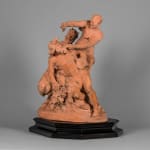Alfred Drury 1856-1944
36.4 x 22 x 33 cm
Further images
Drury's terracotta figure group The Triumph of Silenus was the first work he exhibited at the Royal Academy after his return from Paris, where he had been working as an assistant in Dalou's studio. In 1885 it was listed number 2096 in the Royal Academy catalogue, with Drury giving his address as 9 Alma Villas, Richmond. In his article 'Our Rising Artists: Alfred Drury', Baldry wrote of this work that: 'towards the end... of his stay in Paris, he found time to execute at least one piece of work to show in what manner he had profited by his chances. He sent to the Academy in 1885 a terracotta group, half-life size, representing The Triumph of Silenus which he had modelled in the previous year'. Spielmann wrote of the same work that: 'this clever work, wisely modelled in terracotta - for such material the subject and the character inspires - gives far too close an imitation, if that be not too hard a word, of the master's style'.
The master in question was, of course, Aimé Jules Dalou - and one wonders if Drury and Dalou were sharing a private joke on both sides of the channel as in the same year, 1885, Dalou was exhibiting the plaster model of his work of the same title in the Paris Salon (Le Triomphe de Silène, 1898, Jardin du Luxembourg, Paris). Baldry is somewhat kinder, intimating that it was hardly surprising if, after working for so long in Paris with Dalou, Drury had acquired 'something of the taste and feeling' of his master. Ever loyal to his friend from student days, Baldry also stated that The Triumph of Silenus was 'an example of his judicious adaptation of those principles of free and florid design which he had seen so well applied in the productions of M. Dalou, but also... an illustration of his ingenuity in overcoming the special difficulties inseparable from the handling of the material employed. Technically it was of excellent quality, rich and ample in its forms... suited to so animated and joyous a motif'. Indeed, Drury's first exhibit at the Royal Academy does appear to be a deliberate example of the technical skill of the artist both in the use of the material and in the modelling of the playfully entwined figures, the composition following the classic lines of the influential Laocoon Group which all students would at some point in their training have drawn from a cast.
Dalou's version of the Silenus group was a more exuberant and complex rendition of the subject intended for display in the Jardin du Luxembourg, whereas Drury's was a virtuoso exercise to display his modelling ability on his return to England. What is clear, however, is that the figure of Silenus was undoubtedly derived from the same model for both groups. Silenus was a rural Greek god and one of Bacchus's drunken retinue. He is usually depicted in the triumphal procession of Bacchus either on an ass or carried by satyrs holding drinking cups and grapes while maenads clash cymbals (for example, see the fresco by Annibale Carracci in the Farnese Gallery in Rome). Fat and old, Silenus was also wise and had the gift of prophecy. As Drury's first exhibit on his return to London, The Triumph of Silenus was both a wise choice of subject, a triumph of execution and an indicator of his stylistic allegiance to Dalou.
Jane Winfrey, 2013.
Both Susan Beattie and Simon Poë have made reference to the significant influence the artist and sculptor Alfred Stevens also had on Drury's work (second only to Dalou), so much that in Beattie's seminal work on the New Sculpture movement she argues that Stevens prepared the ground for those that followed.
Provenance
Alfred Drury RAPaul Drury
By direct decent
Exhibitions
2013: 2013-2014: Alfred Drury and the New Sculpture exhibition, University of Kent, Canterbury (20 Sep-1 Dec) and University of Leeds (15 Jan-13 April), a teracotta miniature of the half-life-size version was on display1885: Royal Academy
1885: Grosvenor Gallery
Literature
Ben Thomas (ed.), Alfred Drury and the New Sculpture, exh. cat (Canterbury: Studio 3 Gallery, 2013).Jeremy Cooper, 19th Century Romantic Bronzes (London: David and Charles, 1975), p. 88.
Kineton Parkes, Sculpture of Today, 2 vols (London: Chapman and Hall, 1921), vol I, p 80.
Algernon Graves, The Royal Academy of Arts: A Complete dictionary of Contributors and their Work from its Foundation in 1769 t0 1904 (London: Henry Graves and Co. Ltd. and George Bell and Sons, 1905-1906), p. 377, ref no: 2096.
Alfred Lys Baldry, 'A Notable Sculptor: Alfred Drury, A.R.A', Studio, 37 (1906), pp.3-18, p.10.Marion Harry Spielmann, British Sculpture and Sculptors of Today (London: Cassell, 1901), pp 110, 109, 111.
Alfred Lys Baldry, 'Our Rising Artists: Alfred Drury, Sculptor', The Magazine of Art, 24 (1900), pp. 211-217 (pp. 211, 213).Join our mailing list
* denotes required fields
We will process the personal data you have supplied to communicate with you in accordance with our Privacy Policy. You can unsubscribe or change your preferences at any time by clicking the link in our emails.






